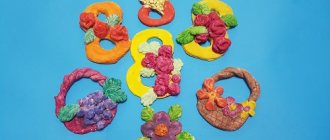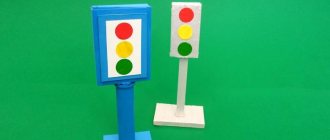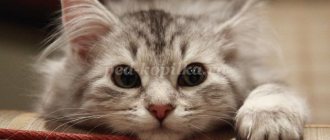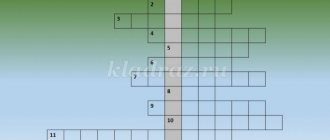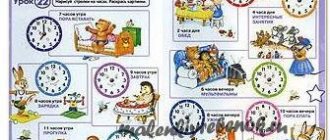Modeling a cat family from clay
If you want to make a real figurine, then instead of plasticine, take another material. For example, clay. This is a popular mass for sculpting souvenirs; it is very easy to work with. Polymer clay (plastic) for crafts is sold in handicraft, art and online stores. This material has its own characteristics:
- Self-hardening clay hardens in air. This may take 2 days.
- Baking clay hardens when heated. It is kept in the oven for 10-30 minutes.
- Clay can be tinted, that is, mixed with paint to obtain all kinds of colors.
- To reliably fasten clay fragments, you need to moisten them with water.
Clay cat
First, make the simplest figurine . For the master class you will need:
- clay;
- modeling board;
- toothpick;
- water in a bowl;
- brush and paints (acrylic or watercolor).
Take the amount of clay with the expectation that you will get a craft of the required size. Let's get started with some fun sculpting:
Divide a piece of clay in two. One segment will make a body. From the second part, sculpt the paws, tail, ears and cheeks.- The body should be shaped like a rounded cone. Press the bottom of the shape onto a flat surface to make it stable.
- Break off fragments from a smaller piece of clay to form ears. These will be two pointed triangles. Moisten these parts with water and connect them to the body.
- In a similar way, mold the remaining elements for the muzzle: voluminous cheeks, eyes, nose. Don't forget also about the last important detail - the tail. Moisten all this in water and secure it to the body.
- Add details to the finished figurine using a sharp toothpick. You can make pupils, a charming smile and dots on the cheeks. The mustache will be made from wire or fishing line.
- Wait for the craft to dry for a couple of days and paint the cat to your taste.
Progress of the lesson:
Guys, you recently visited Yuri Kuklachev’s Cat Theater. Did you like performing cats ?
Children talk about their impressions.
— Do you want to make a cat and organize your own Cat Theater in our group?
- Then let's look at it. What shape is a cat's ?
- What kind of head does our cat ?
- What’s on the cat’s head ?
— Does our cat have a tail ? What is he like?
Long, oval, fluffy.
- How can you blind a cat ?
From pieces: from a ball - a head, from a cylinder - a torso, from small cylinders - legs and a tail.
- I’ll remind you of another sculpting that will help us sculpt cats and show how they move.
Divide the lump of clay in half - cut off in a stack; one half - for the body and paws; the other is for the head and tail. We make a cylinder from one part. Animals usually move on four legs, so the cylinder (roller)
you need to turn it like this
(the teacher turns the cylinder into a horizontal position)
. Then bend it in an arc and cut it at both ends with a stack to make four legs. This is a body with legs. All that remains is to sculpt the head and tail. Tell me how best to do this?
— You and I sculpt not just cats, but cats who are artists. Therefore, the body can be positioned as if the animal is standing on two legs, or on four. And the head can be attached to the body from above or to the side, on the neck or directly on the body.
— There are many artists in the Cat Theater. May you get different cats !
Children begin sculpting , independently choosing a pose for the sculpted cat .
At the end of the work, the teacher says:
- You made a cat , now let's see what your cat , what number it is showing us.
The teacher examines all the sculpted figures and notes the most expressive ones.
- Now let’s choose a place in the group for our Cat Theater so that it’s convenient to organize performances!
On the topic: methodological developments, presentations and notes
Date: February 21, 2012 Participants: children of the preparatory group Conducted by: educational psychologist Panova M.M. Purpose: to promote formation.
Introduce children to number and figure 6. Improve counting skills and comparison of subject aggregates. Form children’s ability to distinguish between the concepts of yesterday, today, tomorrow. Consolidate knowledge about geome.
1. Conduct classes to teach children to notice changes occurring in nature.2. Conducting classes, teaching children to group objects by color and shape.3. Conducting classes, Develop holistically in children.
"These funny cats." Thematic notes for older age. Modeling lesson “Cats-artists”
Elena Meleshko
“These funny cats.”
Thematic notes for older age. Sculpting lesson “Cats-Artists” Sculpting lesson in the senior group “
Cats-Artists ” .
Goal: To teach children to create an animal image in modeling . Strengthen the ability to sculpt from a whole piece using clay cuts from the ends. Use different techniques in work: rolling clay between the palms, pulling small parts, connecting parts by pressing and smoothing the joints. Learn to convey the pose of a cat in sculpting .
Preliminary work: Conversation about pets. Examination of illustrations in books, albums (image of animals by Yu. Vasnetsov,
E. Charushin). Reading of the poem by V. Shipunova “What the Siberian cat dreams of”
. Visit with parents to the Yu. Kuklachev Cat Theater. Looking at a toy cat.
Material: Clay, board, stack, cloth napkin (wet)
for each child, a
cat .
One balloon kitten
If you are considering the topic of plasticine crafts for children and are looking for something simple but beautiful, then the next cat is for you. This character is funny, well-fed and very cute.
Making such a fat cat is very simple, for this:
- Preparing plasticine for work. Choose any shade you like. Heat the material and roll it into a ball. The main figure can be any size. Do you want to get the most well-fed cat? Make a very large ball.
(Step 1) - Additionally, roll a few more balls. We form ovals from the obtained parts. We attach it to the body. Pay attention to the photo of the cat; the hind legs should be slightly larger than the front ones.
(Step 2) - We complement the main figure with a tail. The presentability of our fat man will depend on the length. Roll out the worm, attach it to the ball and wrap the end. Entrust this work to your child, because these plasticine crafts for children are very simple.
(Step 3) - Forming the ears. Roll two small balls or one large one and flatten the workpiece. Cut out the triangles. Carefully attach the finished triangles to the ball and slightly turn the ears at the end inward for volume.
We figured out how to mold the base of a cat from plasticine; it needs to be supplemented with small elements so that a certain facial expression appears.
Follow these steps:
- We continue to work with the main color. Let's make two peas. They will become cheeks. We attach them to the muzzle and carefully smooth them out.
- To make the cat have the same facial expression as in the photo, make a third ball and place it below the cheeks.
- Let's make a nose. Choose a color. Of course, pink will look cutest. Roll the ball and secure it in place.
- Now you need to make the eyes. Wash your hands before handling them, because you will have to work with white. Dirty hands may leave marks on the material.
- Roll out two white peas. We attach the pupils to them; it is not necessary to use plasticine as the pupil, you can place beads of the color you need here.
- We can't leave our furry pet without a mustache. To make them you can use white thread or fishing line. Gently insert the mustache into your cheeks.
- We complete the creation of the cat. Use small white triangles to make fangs for the cat. Draw the animal’s fingers, holes on its nose and cheeks.
Look, we learned how to mold a well-fed cat from plasticine! This toy is ideal for any children. If you want to keep this plump cat company, you can choose a friend for him from the article on how to make animals from plasticine.

